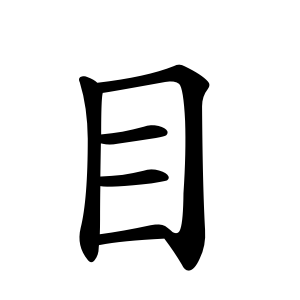目
- eye;
It is also used to mean "vision," "sight," or "viewpoint."
Etymology
It is a pictograph modeled after the shape of a human eye. Originally, it was written more horizontally like an eye, but over time it evolved to be written more vertically. It is an important radical used in many characters.
The character 見 (to see) contains 目 as a component but is classified as a phono-semantic compound. Words related to "eye" are often written using 眼 (eye as a body organ) to specifically refer to the physical eye. In everyday use, 眼 is more commonly used when referring to the eye as a bodily organ.
Usage in Korean
The character 目 often appears as a radical either as a side component (변) or a bottom component (발) in other Chinese characters. Most characters that use 目 as their radical relate to seeing or parts of the eye/vision.
Representative characters include:
瞻 (to look up, gaze)
瞳 (pupil of the eye)
看 (to look, watch)
眼 (eye)
眉 (eyebrow)
睡 (to sleep, drowsiness)
However, some characters with 目 do not relate directly to eyes or vision, such as: 眞 (true), 盾 (shield).
Alternative forms
𤶽 (mụt)
Characters with 目
- 月山 (BU)
- ⿴ 囗 𠄠
